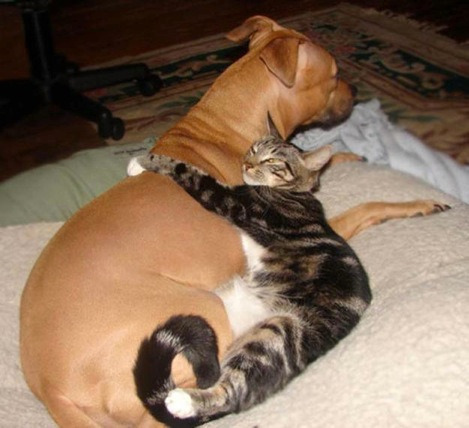<p>When it comes to pets, there&#8217;s practically nothing we as owners won&#8217;t do for them. For many pet owners, Fido or Fluffy isn&#8217;t just a pet but rather a member of the family. Many pets are thought of as children, and as such need to be protected just like parents would protect their kids. To accomplish this, there are a number of things we as pet owners can do around the house to make it as pet-friendly as possible.</p>
<p style="text-align: center;"><img class="aligncenter" src="http://myblogguest.com/forum/uploads/articles/2013/9/8364269735_f836463041.jpg" alt="" width="480" height="440" /></p>
<p> To make a home pet-friendly, you need to think like your pet. Take a walk around your home, trying to imagine what you would do if you were a dog or cat strolling around these surroundings. Look for places where a pet could squeeze in and then get stuck, such as behind a refrigerator or dishwasher. Keeping kitchen cabinets closed is also a good way to ensure your pet won&#8217;t get into trouble.</p>
<p>Not only can they get stuck inside the cabinet, but they can also get into such things as household cleaners or foods that may be harmful to them. Make sure doors that lead to balconies or windows that are low to the ground stay shut and locked, especially when you&#8217;re not home. Many times pets get excited while playing and accidentally jump off or run off of balconies, getting injured or even killed.</p>
<p>Pets are naturally curious, and usually just can&#8217;t resist checking out anything that&#8217;s left setting on the floor. Many times we get careless and leave out such items as antifreeze, pesticides and air fresheners. Cats and dogs are particularly drawn to antifreeze for its sweet taste, and unfortunately what may taste good going down can be harmful if not fatal. Antifreeze can destroy an animal&#8217;s kidneys, so keeping this high off the floor and locked away is a must.</p>
<p>Garbage is another item that peaks our pets curiosity, and what we look at as garbage is sometimes looked upon as a feast by dogs and cats. Some foods that we humans may love such as chocolate, grapes, mushrooms and raisins can be toxic to our pets, so make sure if these are thrown out in the trash the pets can&#8217;t get to them. Emptying the trash daily can often take care of this issue, but it may also be a good idea to get a garbage can with a lid that fits securely or place the garbage can in a locked cabinet to avoid any surprises.</p>
<p>Also, look out for the possible mold growth in the corners of your house, because pets can get a serious health problems because of it. If you spot any mold, call moldbusters immediately and get your pet somwehere safe away from the mold, untill they remove it.</p>
<p>If you have a green thumb and love to have plants throughout your house, be very careful which ones your pets have access to. Many houseplants, while very beautiful on the outside, can be very dangerous to your pets. Such plants as poinsettias, carnations and lilies can be poisonous to your pets, so either avoid these altogether or put them somewhere out of reach, such as in a hanging basket high off the ground.</p>
<p>Once you&#8217;ve got the house pet-proofed, it&#8217;s time to give your furry bundle of joy their own personal space. Giving them a bed of their own that&#8217;s comfortable and clean can make all the difference to them. If your pet is older and perhaps suffers from arthritis, be sure the bed is roomy and has plenty of cushion to support sore joints. If you have any toys for your pet, make sure they are not so small that they can be swallowed.</p>
<p>Try to keep away any children&#8217;s toys, and make sure the pet&#8217;s bed is placed in a quiet, out of the way area that&#8217;s free of foot traffic and noise. Be sure their food and water are placed nearby as well, and always have the dishes clean and full of fresh food and water.</p>
<p>By taking a few precautions and keeping your pet&#8217;s best interests in mind, you and your pet can have a happy home that will provide years of great memories.</p>
<h5>Featured images:</h5>
<p><span class="license">License: Creative Commons</span></p>
<p><span class="source">image source</span></p>
<p>Robert and Nicole have two cats and one dog. Last year their dog had some serious health problems because of mold growth. Here are a few tips Bob and NBicole shared with other pet woenrs about pef safety indoors.</p>

How To Have A Pet-Friendly Home
